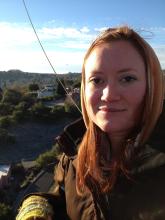MA Alumni

With an M.A. in Public Sociology from Cal Poly Humboldt (Humboldt), I came to obtain the professional experience and academic background necessary for the advancement of my career in the environmental non-profit sector.
There is great value in hands-on work experience as a means of augmenting academic learning, and that is one of the many reasons why I chose to enroll in Humboldt’s Public Sociology program beginning in the fall of 2011. My decision to invest in this program stemmed from my desire to obtain a deeper and more holistic understanding of the ways in which race, class, and gender intersect and shape human relationships with the natural environment. Because Humboldt offers a Practicing emphasis, the program offered me the freedom to explore my interests while equipping me with invaluable practical tools and critical analytical skills that I now put to use on a daily basis.
Early in 2013, I began my Project Placement with a non-profit organization based in Southern Humboldt County called Sanctuary Forest. Our goal was to determine the social and ecological feasibility of conducting a “technology transfer” of an innovative voluntary water conservation program from the Mattole River watershed to the neighboring Redwood Creek watershed. Redwood Creek is a 26 square-mile watershed that flows into the South Fork of the Eel River near Redway, California. It also happens to be located adjacent to the Mattole watershed, and suffers from many of the same cumulative impacts—including residential water diversions—that have led to serious concerns about water scarcity for both people and endangered salmon.
To address these concerns, I worked with Sanctuary Forest and another organization called Salmonid Restoration Federation on the development of The Redwood Creek Water Conservation Project. This project was designed to gather baseline data about low summertime water flows in the watershed, to gauge public interest in establishing a voluntary water conservation program similar to the one in the Mattole, and to understand the type of water conservation program that might be appropriate for the Redwood Creek watershed and its rural residents.
My involvement in the development and implementation of The Redwood Creek Water Conservation Project enabled me to put many newly acquired skills to use. I collected and analyzed quantitative data on human water use patterns and behaviors via a survey questionnaire to 400 landowners, hosted a focus group, conducted extensive public outreach through local media outlets, coordinated free water conservation workshops and field tours for local residents, developed educational materials on water conservation methods and water rights, gathered public feedback to address barriers to participation, and produced reports to provide updates for participants and funders on the progress and findings of the feasibility study.
Over the course of two years, this graduate project has grown into a long-term program with secured funding from state agencies, private foundations, and the active participation of eight regional and statewide partners.
With guidance from my Project Placement Advisor at Sanctuary Forest, I produced Resilience in a Time of Drought: A Transferable Model for Collective Action in North Coast Watersheds. This document is a practical ‘how-to’ guide for community members, restoration practitioners, non-profits, and other stakeholders wishing to establish a voluntary water conservation program in their watershed. This guide was developed based on the methods and findings of The Redwood Creek Water Conservation Project.
Shortly after graduation from Humboldt in 2014, I was hired as a full-time Program Manager for Salmonid Restoration Federation, where I am responsible for the ongoing implementation and grant oversight of The Redwood Creek Water Conservation Project. Our organization coordinates frequent opportunities for dialogue and collaboration between rural residents, Humboldt County elected representatives, and state agency stakeholders regarding drought resilience in North Coast watersheds, often through the production of public forums and workshops. Additionally, I provide consultation to rural residents with coming into compliance with state water law within the Five County region and coordinate the logistics for multiple annual statewide events.

